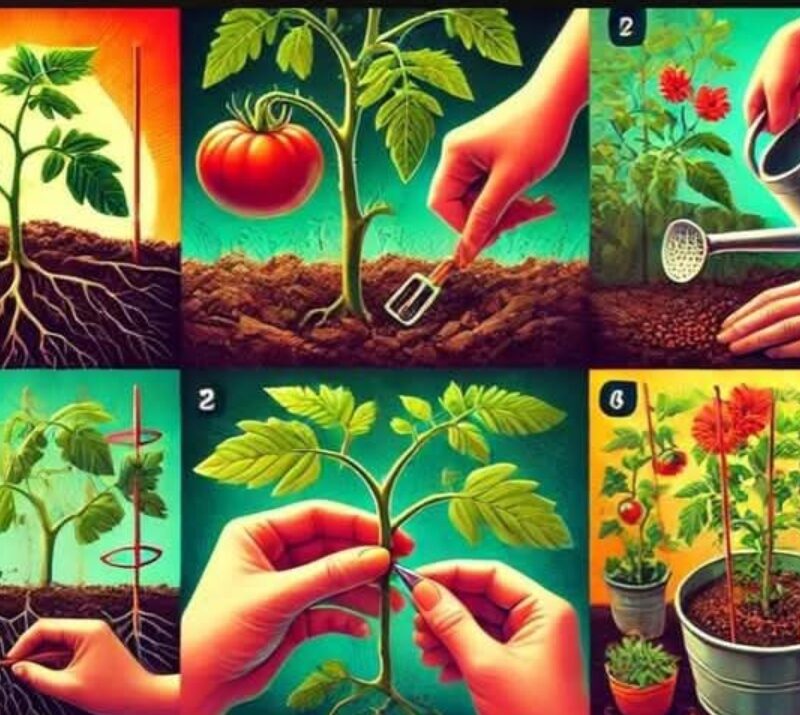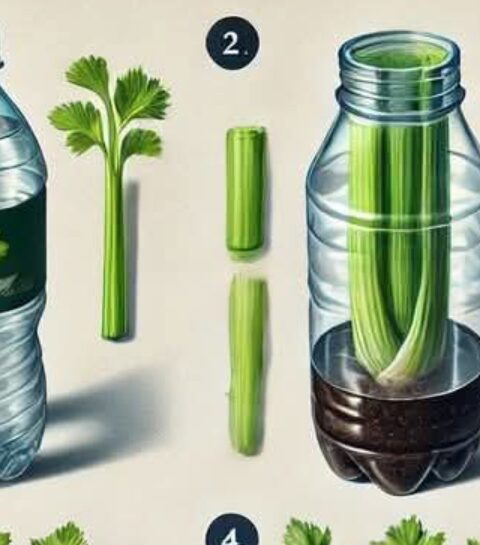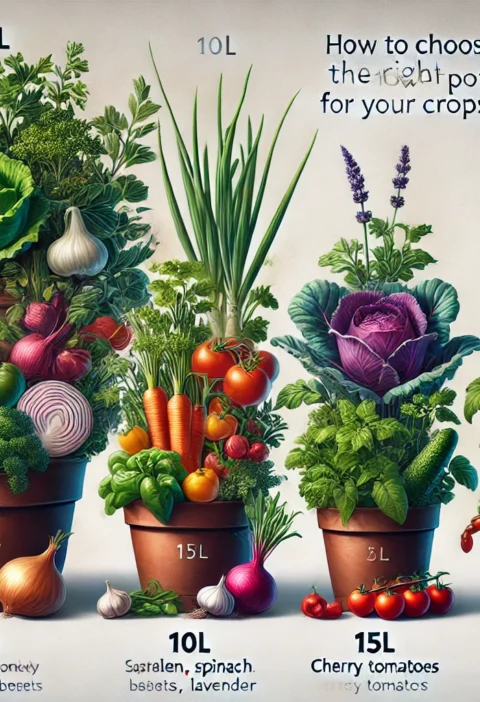Tomatoes (Solanum lycopersicum) have an intriguing history. They originated in South America, with the earliest cultivation dating back over 2,500 years in the Andes Mountains. The Aztecs and Incas cultivated them long before they were introduced to Europe in the 16th century by Spanish explorers. Initially, Europeans believed tomatoes were poisonous due to their bright red color and relation to the deadly nightshade plant. However, over time, tomatoes became a culinary staple across the globe.
Today, tomatoes are one of the most widely grown crops in the world, and gardeners are constantly searching for ways to improve their growth, flavor, and yield.
—
Super Tips to Grow a Ton of Tomatoes! 🌿✨
1. Plant Tomato Stems Deeply for Stronger Roots 🌱
Tomato plants have a unique ability to grow roots from their stems. When planting tomato seedlings, bury two-thirds of the stem in the soil to encourage a larger and stronger root system. This deep planting method helps plants:
✔ Absorb more nutrients and water
✔ Become more stable against wind and heavy fruit
✔ Increase drought resistance
Pro Tip: If you have leggy seedlings, lay them sideways in a trench and cover them with soil, allowing only the top leaves to remain exposed. The buried stem will develop roots, creating a sturdier plant.
—
2. Remove Lower Leaves to Prevent Disease 🍂
As tomato plants grow tall, their lower leaves are more likely to come in contact with soil-borne diseases like blight and fungal infections. Pruning the lower leaves helps:
✔ Improve air circulation around the base
✔ Prevent moisture buildup that leads to mold
✔ Reduce the risk of soil splashing onto leaves
Best Practice: Start removing lower leaves once the plant is about 12-18 inches tall and continue pruning throughout the season.
—
3. Pinch Off Side Shoots for Bigger, Better Tomatoes ✂
Tomatoes produce small side shoots, also known as “suckers,” between the main stem and branches. While these shoots can grow into new stems, they take energy away from fruit production.
✔ Pinch off suckers early to direct energy toward fewer but larger tomatoes
✔ Helps create an open plant structure for better light penetration
✔ Reduces overcrowding, improving overall plant health
—
4. Add Mulch to Retain Moisture and Protect Plants 🌾
Mulching is one of the best ways to keep soil moisture levels steady while protecting tomatoes from heat stress and diseases.
✔ Helps retain moisture, reducing the need for frequent watering
✔ Prevents soil-borne pathogens from splashing onto leaves
✔ Keeps weeds from competing with tomatoes for nutrients
Best Mulches for Tomatoes:
✔ Straw – Lightweight, keeps the soil cool
✔ Grass clippings – Adds nutrients as they decompose
✔ Shredded leaves – Retains moisture effectively
—
5. Use Copper Strips to Keep Slugs and Snails Away 🐌
Slugs and snails can destroy tomato plants overnight, especially when they’re young. Copper strips act as a natural repellent, giving pests a slight electrical shock when they come into contact with them.
✔ Place copper around the base of plants or containers
✔ Keeps slugs and snails from climbing up to eat leaves
✔ Safe, chemical-free pest control
—
6. Support Tomatoes with Stakes or Cages 🌿
Tomatoes grow best when they are properly supported. Without support, plants can become heavy and collapse, leading to broken stems and rotten fruit.
✔ Stakes – Drive wooden stakes into the ground and tie the plants with soft twine
✔ Cages – Best for bushy tomato varieties, keeping fruit off the ground
✔ Trellises – Ideal for indeterminate tomato varieties, which grow tall
Pro Tip: Install support before plants grow too big to prevent damage to roots.
—
7. Space Plants Apart for Better Airflow 🌬
Crowded tomato plants are more prone to fungal diseases and poor fruit development due to competition for nutrients.
✔ Space plants 18-24 inches apart for best results
✔ Encourages better air circulation, reducing disease risk
✔ Provides more sunlight exposure, leading to sweeter tomatoes
—
8. Water at the Base to Prevent Cracking and Disease 💧
Tomatoes hate wet leaves, and overhead watering can lead to fungal infections and fruit cracking.
✔ Always water at the base of the plant
✔ Use soaker hoses or drip irrigation for even moisture
✔ Water in the morning to allow any excess moisture to evaporate
How Often to Water:
✔ During hot weather: Daily, early in the morning
✔ Cooler conditions: Every 2-3 days
—
9. Add Epsom Salt for Healthier Growth 🧂
Epsom salt (magnesium sulfate) provides essential nutrients for healthy tomato plants.
✔ Enhances chlorophyll production for greener leaves
✔ Prevents blossom end rot (caused by magnesium deficiency)
✔ Improves fruit production for a bigger harvest
How to Use:
✔ Mix 1 tablespoon per gallon of water and spray every 2 weeks
✔ Sprinkle 1 tablespoon per plant around the soil before watering
—
10. Water Deeply and Slowly for Strong Roots 🌊
Shallow watering leads to weak roots and inconsistent growth. Tomatoes prefer deep, slow watering to encourage strong root development.
✔ Water deeply once or twice a week, rather than frequent light watering
✔ Ensures moisture reaches deeper soil layers, where roots grow
✔ Helps plants survive drought conditions better
—
11. Plant Marigolds to Repel Pests Naturally 🌼
Marigolds are companion plants that help protect tomatoes from pests like aphids, nematodes, and whiteflies.
✔ Deter harmful insects naturally
✔ Attract pollinators like bees
✔ Improve soil health and biodiversity
How to Plant:
✔ Space marigolds around the edges of tomato beds
✔ Use French marigolds, which are best for pest control
—
12. Grow Garlic Near Tomatoes for Flavor and Protection 🧄
Garlic not only enhances the flavor of tomatoes but also wards off common tomato pests like aphids and spider mites.
✔ Natural antifungal properties protect against diseases
✔ Improves soil health with sulfur compounds
✔ Boosts tomato flavor due to shared nutrients
Best Practice:
✔ Plant garlic bulbs between tomato plants
✔ Harvest garlic at the end of tomato season
—
Final Thoughts: Enjoy a Bumper Crop of Delicious Tomatoes! 🌟🍅
By following these expert tomato-growing tips, you can achieve a huge harvest of healthy, flavorful tomatoes all season long. Whether you’re growing in pots, raised beds, or a large garden, these methods will ensure success.
✅ Deep planting for strong roots
✅ Pruning and spacing for better airflow
✅ Proper watering techniques to prevent disease
✅ Companion planting for natural pest control
Try these super tips and get ready to enjoy the best homegrown tomatoes ever!






